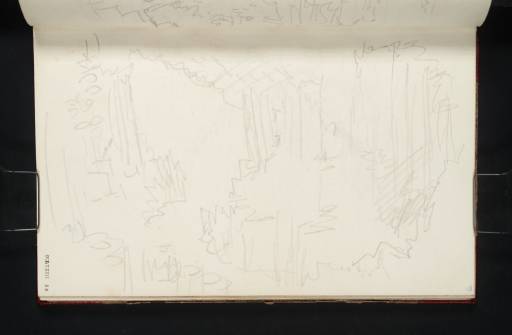J.M.W. Turner
>
1830-35 Annual tourist
>
Scotland 1831
>
Staffa Sketchbook
>
Artwork
Joseph Mallord William Turner Fingal's Cave, Staffa 1831
Image 1 of 2
Joseph Mallord William Turner,
Fingal's Cave, Staffa
1831
Joseph Mallord William Turner 1775–1851
Folio 29 Recto:
Fingal’s Cave, Staffa 1831
D26797
Turner Bequest CCLXXIII 29
Turner Bequest CCLXXIII 29
Pencil on white wove paper, 116 x 186 mm
Inscribed in blue ink by John Ruskin ‘29’ bottom right descending vertically
Stamped in black ‘CCLXXIII 29’ bottom left descending vertically
Inscribed in blue ink by John Ruskin ‘29’ bottom right descending vertically
Stamped in black ‘CCLXXIII 29’ bottom left descending vertically
Accepted by the nation as part of the Turner Bequest 1856
Exhibition history
1975
Turner and the Poets: Engravings and Watercolours from his Later Period, Marble Hill House [Greater London Council], Twickenham, April–June 1975, University of East Anglia, Norwich, June–July 1975, Central Art Gallery, Wolverhampton, July–August 1975 (XV).
References
1909
A.J. Finberg, A Complete Inventory of the Drawings of the Turner Bequest, London 1909, vol.II, p.876, CCLXXIII 29, as ‘Fingall’s Cave, Staffa. See Engraving Scott’s Poems 1834’.
1975
Mordechai Omer, Turner and the Poets: Engravings and Watercolours from his Later Period, exhibition catalogue, Marble Hill House [Greater London Council], Twickenham 1975, p.[32] cat.XV.
1982
Francesca Irwin, Andrew Wilton, Gerald Finley and others, Turner in Scotland, exhibition catalogue, Aberdeen Art Gallery and Museum 1982, p.54 under cat.75.
1984
Martin Butlin and Evelyn Joll, The Paintings of J.M.W. Turner, revised ed., New Haven and London 1984, p.198 under cat.347.
1987
Andrew Wilton, Turner in his Time, London 1987, pp.194, 195 reproduced pl.268.
1992
Anne Lyles, Turner: The Fifth Decade: Watercolours 1830–1840, exhibition catalogue, Tate Gallery, London 1992, p.46.
1998
James Hamilton, Turner and the Scientists, exhibition catalogue, Tate Gallery, London 1998, pp.121 reproduced fig.122 as ‘Interior of Fingal’s Cave, off the Isle of Staffa’, 141.
1990
Luke Herrmann, Turner Prints: The Engraved Work of J.M.W. Turner, Oxford 1990, pp.200, 258, note 34.
This is one of several sketches of the interior of Fingal’s Cave (folios 27 verso–29 verso, 30 verso; D26794–D26798, D26800). Although none of the sketches is very close to the composition of Turner’s watercolour, Fingal’s Cave, Staffa circa 1833–4 (whereabouts unknown),1 engraved for the Lord of the Isles volume of Sir Walter Scott’s Poetical Works, the current sketch has been regarded by several scholars as the basis for the composition, or at least the closest sketch to the final design.2 The major difference between the current sketch and the watercolour, however, is that it is from the left side of the cave, while the watercolour shows a view as if from the right, as in William Daniell’s depiction of the cave for A Voyage Round Great Britain (1814–25): In Fingal’s Cave, Staffa (aquatint, Tate T02796). The viewpoint of the Scott design is closest to a rough sketch on folio 29 verso (D26798). The current sketch, however, provides more detail of the appearance of the inside of the cave, and is roughly a mirror image of the watercolour design. Turner made a very similar sketch to this on a loose sheet of light-grey paper: Tate D34002 (Turner Bequest CCCXLI a 285).
From near the back of the cave we look towards the cave entrance. The cave, and most of the island of Staffa, is made up of volcanic basalt that has crystallised into columns (in the same formation as the Giant’s Causeway, County Antrim, Ireland). Although Turner’s sketch is rapidly executed, the structure and appearance of the cave is clear. Public interest in Fingal’s Cave in the nineteenth century had followed from the geological descriptions of the cave by Joseph Banks, an account of which was published in Thomas Pennant’s A Tour in Scotland.3 The geologist John Macculloch also wrote an article on the cave in The Transactions of the Geological Society (no.II, 1814), a copy of which was owned by Turner (as John Gage points out). Macculloch wrote about the cave again in his book The Highlands and Western Isles of Scotland (1824) which Sir Walter Scott may have shown to the artist.4 His description is both scientific and romantic, and he described the view from within the cave as ‘picturesque.’ Turner was therefore armed with some geological understanding of the cave, as well as the anticipation that it would provide him with a good artistic subject.
For a full list of Turner’s sketches of the Isle of Staffa and Fingal’s Cave, see folio 40 (D26817).
Thomas Ardill
March 2010
How to cite
Thomas Ardill, ‘Fingal’s Cave, Staffa 1831 by Joseph Mallord William Turner’, catalogue entry, March 2010, in David Blayney Brown (ed.), J.M.W. Turner: Sketchbooks, Drawings and Watercolours, Tate Research Publication, December 2012, https://www


